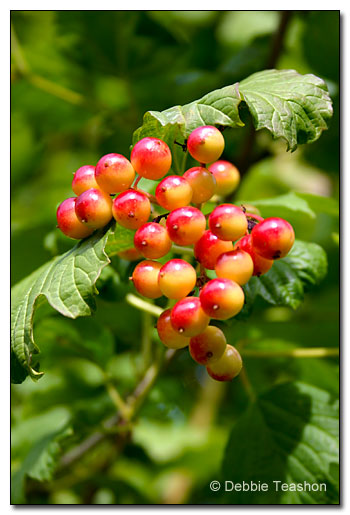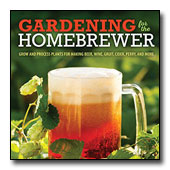Viburnum trilobum
HIGH BUSH CRANBERRY
Family: Caprifoliaceae
Pronounced: vy-BURN-um try-LOW-bum

Quick Jumps
Growing Guide
Rainy Side Notes
GROWING GUIDE

Origin:
North America.
Plant Group:
Shrub.
Hardiness:
Sunset zones: A-1-A3, 1-11, 14-20.
USDA zones: 2-7.
Heat zones: 7-1.
Mature size:
Height 10-15 feet (3-4.5 m).
Width: 12 feet (3.5 m).
Flowering period:
Late spring.
Flowering attributes:
Four-inch, snow white, lacecap flowers, followed by bright red, translucent berries.
Leaf attributes:
Dark green, five-inch, maple-like leaves.
Growth habit:
Rounded shrub.
Light:
Full sun to partial shade.
Soil:
Fertile, moist, well-drained soil.
Propagation Methods:
Sow seed in autumn.
Greenwood cutting and semi-ripe cuttings in summer.
Pruning Methods:
Prune after flowering.
Rainy Side Notes

Hydrangeas aren't the only shrubs that produce lacecap flowers. In the spring, the exquisite beauty of Viburnum trilobum's pure white sterile blossoms, which surround the peach-hued buds that open into fertile, tiny white flowers.
For a practical landscaping choice, I opted to cultivate the high bush cranberry as a deciduous hedge. Planted with a spacing of approximately three feet apart, it has flourished, reaching an impressive height of nearly eight feet. The shrub's dense foliage has proven to be an excellent natural hedge, providing both privacy and aesthetic appeal.
It was a fascinating sight to see the birds' interaction with the high bush cranberry. It took them about three years to discover the berries. Once the cedar waxwings found them, they swiftly devoured all the berries on the shrub, leaving it bare. When before the berries would hang on the shrub well into spring the following year.
Bright red berries and leaves take over the show in the fall. The sweet autumn clematis vine, Clematis terniflora, vigorously climbs over the viburnum, thumbing its nose at the inadequate trellis I provided. Numerous clusters of the viburnum berries hang on the shrub, topped by the clematis's highly fragrant, vibrant white flowers.

Photographed in author's garden.

Gardening for the Homebrewer: Grow and Process Plants for Making Beer, Wine, Gruit, Cider, Perry, and More
By co-authors Debbie Teashon (Rainy Side Gardeners) and Wendy Tweton.

